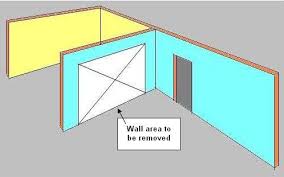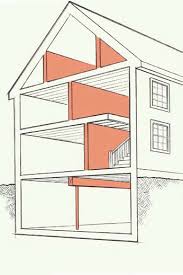Alterations Inside Your Home - Part Two← Back
Posted 10 Years, 8 Months, 1 Week, 18 Hours, 55 Minutes ago.
In this part of our series of blogs about altering the inside layout of your home, we look at some points about removing internal walls.

This must be done very carefully as some walls will be structually important to the building and some have an important role as fire protection to the stairway. Others are quite straightforward to alter and remove as they would have been constructed to simply divide up the house into individual rooms.
If a wall is load-bearing then you must seek Buildings Regulation consent before they can be removed or altered. In nearly all cases, you will need to consult a structural engineer to design a supporting structure to ensure that the loads are safely transmitted to the ground.
Here are some key questions that need to answered before removing an internal wall:
Is it load-bearing?
If you answer this question incorrecly then you're in serious trouble. It may not always be obvious which walls are load-bearing and which are just partitions. In the majority of properties, particularly the older ones, the internal walls will normally be supporting roof loadings, floor joist or walls upstairs.
Does it protect you from fire?
To alter a wall that protects you from fire, you must seek Building Regulation approval, even if they are not load-bearing. These are usually around staircases to allow you to escape in the event of a house fire. Similarly, partition walls that are in place to separate entrance halls from reception rooms should also be left in-tact as they form fire escape corridors.
If you are looking to convert your loft, again you need to get Building Regulation approval. These walls are known as storeys and if removed mains-operated smoke detectors must be installed and windows upstairs must be suitable for fire escape.
How can you tell if an internal wall is 'structural'?
As some stud walls are load-bearing, it makes it a bit of a myth that if you tap a wall and it sounds hollow it is just a studwork dividing wall. On the other hand, solid masonry walls aren't necessarily always structural walls. Some of them are still just partition walls. There are a few things that you can check to see if a wall is structural, but never take any risks and seek advice if you are unsure.
any risks and seek advice if you are unsure.
Roof loadings - In older properties the roof structure often relies on support from internal walls.More modern roofs that were introduced in the late 1960's with W' shaped trusses are designed to span the support right across the house from main wall to another without internal support.
Floor Loadings - Floor joists rarely span more than about four metres without support from an internal wall or beam. Look for nail runs in floorboards to see the direction of joists (at right angles to direction of floor boards).
Loadings from Walls Above - Ground floor walls often extend upstairs as bedroom walls. However, sometimes upstairs walls are offset or supported on a beam. Most modern houses have lightweight stud walls to the upper floors.
Lateral Support - In older houses, internal walls often provide ‘lateral support’ helping to tie together the adjoining walls either side.
This must be done very carefully as some walls will be structually important to the building and some have an important role as fire protection to the stairway. Others are quite straightforward to alter and remove as they would have been constructed to simply divide up the house into individual rooms.
If a wall is load-bearing then you must seek Buildings Regulation consent before they can be removed or altered. In nearly all cases, you will need to consult a structural engineer to design a supporting structure to ensure that the loads are safely transmitted to the ground.
Here are some key questions that need to answered before removing an internal wall:
Is it load-bearing?
If you answer this question incorrecly then you're in serious trouble. It may not always be obvious which walls are load-bearing and which are just partitions. In the majority of properties, particularly the older ones, the internal walls will normally be supporting roof loadings, floor joist or walls upstairs.
Does it protect you from fire?
To alter a wall that protects you from fire, you must seek Building Regulation approval, even if they are not load-bearing. These are usually around staircases to allow you to escape in the event of a house fire. Similarly, partition walls that are in place to separate entrance halls from reception rooms should also be left in-tact as they form fire escape corridors.
If you are looking to convert your loft, again you need to get Building Regulation approval. These walls are known as storeys and if removed mains-operated smoke detectors must be installed and windows upstairs must be suitable for fire escape.
How can you tell if an internal wall is 'structural'?
As some stud walls are load-bearing, it makes it a bit of a myth that if you tap a wall and it sounds hollow it is just a studwork dividing wall. On the other hand, solid masonry walls aren't necessarily always structural walls. Some of them are still just partition walls. There are a few things that you can check to see if a wall is structural, but never take
Roof loadings - In older properties the roof structure often relies on support from internal walls.More modern roofs that were introduced in the late 1960's with W' shaped trusses are designed to span the support right across the house from main wall to another without internal support.
Floor Loadings - Floor joists rarely span more than about four metres without support from an internal wall or beam. Look for nail runs in floorboards to see the direction of joists (at right angles to direction of floor boards).
Loadings from Walls Above - Ground floor walls often extend upstairs as bedroom walls. However, sometimes upstairs walls are offset or supported on a beam. Most modern houses have lightweight stud walls to the upper floors.
Lateral Support - In older houses, internal walls often provide ‘lateral support’ helping to tie together the adjoining walls either side.
If in doubt the best advice is to consult a structural engineer or building surveyor, but in most cases a Building Regulations application will need to be made.
Architectural Building Design Services are happy to advise on any building and alteration work that you have planned.
The next part in the series will focus on Structural Alterations so come back and have a read soon!
Architectural Building Design Services are happy to advise on any building and alteration work that you have planned.
The next part in the series will focus on Structural Alterations so come back and have a read soon!
